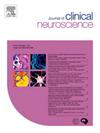Hemorrhagic transformation after thrombolytic therapy for acute ischemic stroke: Accuracy and improvement of existing predictive models in a rural population of the Midwest
IF 1.8
4区 医学
Q3 CLINICAL NEUROLOGY
引用次数: 0
Abstract
Background
Hemorrhagic transformation (HT) after rtPA in acute ischemic stroke is a known complication of thrombolytic therapy. Several grading scales have been introduced in clinical practice, aiming to quantify the risk of HT before rtPA is administered. The goals of this study are to evaluate the performance of existing grading scales in a rural population of the Midwest and improve the existing models.
Methods
This is a retrospective study of stroke patients treated with thrombolytics at Southern Illinois Healthcare from July 2017 to August 2024. Demographics, clinical presentations, laboratory values, neuroimaging, and stroke metrics were collected. HT found on neuroimaging within 24 h after rtPA was reviewed. mRS at 30 days was noted. The cohort was divided in two groups: HT and no-HT. The two groups were compared by univariate analyses. SEDAN, HAT, MSS, and THRIVE scores were calculated, and multivariable logistic regression analysis was run for each model. Area under the receiver operating characteristic curve (AUC) with its 95 % confidence interval was calculated for each grading scale. P value was set at 0.05.
Results
Out of 279 patients included in this study, HT occurred in 8.6 % of patients (n = 24), whereas 91.4 % (n = 255) had no-HT. The two groups were similar in baseline characteristics and stroke severity. HT group had significantly worse mRS 0–2 at 30 days (42 % vs. 69 %, p < 0.05). SEDAN score demonstrated the highest accuracy in predicting HT after rtPA (AUC = 0.65, 95 % CI:0.56–0.75). Adding 1 point for smoking to the score, SEDAN-S, improved the accuracy of the model (AUC = 0.67, 95 % CI:0.57–0.77).
Conclusions
Existing predictive scales of HT after rtPA underperform in our rural population. Among those, SEDAN score is the most accurate predictor. Adding smoking status to the score improves its accuracy. Further larger studies in similar rural populations should be performed to confirm our results.
急性缺血性中风溶栓治疗后的出血转化:中西部农村人口中现有预测模型的准确性和改进。
背景:急性缺血性卒中 rtPA 治疗后出血转化(HT)是溶栓治疗的一种已知并发症。临床实践中已经引入了几种分级表,目的是在使用 rtPA 之前量化出血性转化的风险。本研究的目的是评估现有分级表在中西部农村人口中的表现,并改进现有模型:这是一项回顾性研究,研究对象为 2017 年 7 月至 2024 年 8 月在南伊利诺伊州医疗保健机构接受溶栓治疗的卒中患者。收集了人口统计学、临床表现、实验室值、神经影像学和卒中指标。回顾了 rtPA 后 24 小时内神经影像学发现的 HT。组群分为两组:HT 组和无 HT 组。通过单变量分析对两组进行比较。计算 SEDAN、HAT、MSS 和 THRIVE 评分,并对每个模型进行多变量逻辑回归分析。计算了每个分级表的接收者操作特征曲线下面积(AUC)及其 95 % 置信区间。P 值设定为 0.05:本研究共纳入 279 例患者,其中 8.6% 的患者(n = 24)发生过高血压,而 91.4% 的患者(n = 255)未发生过高血压。两组患者的基线特征和中风严重程度相似。高血压组患者 30 天后的 mRS 0-2 明显更差(42% 对 69%,P 结论:高血压组患者 30 天后的 mRS 0-2 明显更差:现有的 rtPA 后 HT 预测量表在我国农村人口中表现不佳。其中,SEDAN 评分是最准确的预测指标。在评分中加入吸烟状况可提高其准确性。应在类似的农村人口中开展更大规模的研究,以证实我们的结果。
本文章由计算机程序翻译,如有差异,请以英文原文为准。
求助全文
约1分钟内获得全文
求助全文
来源期刊

Journal of Clinical Neuroscience
医学-临床神经学
CiteScore
4.50
自引率
0.00%
发文量
402
审稿时长
40 days
期刊介绍:
This International journal, Journal of Clinical Neuroscience, publishes articles on clinical neurosurgery and neurology and the related neurosciences such as neuro-pathology, neuro-radiology, neuro-ophthalmology and neuro-physiology.
The journal has a broad International perspective, and emphasises the advances occurring in Asia, the Pacific Rim region, Europe and North America. The Journal acts as a focus for publication of major clinical and laboratory research, as well as publishing solicited manuscripts on specific subjects from experts, case reports and other information of interest to clinicians working in the clinical neurosciences.
 求助内容:
求助内容: 应助结果提醒方式:
应助结果提醒方式:


